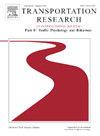分心驾驶的易感性:个性和个人因素的作用
IF 4.4
2区 工程技术
Q1 PSYCHOLOGY, APPLIED
Transportation Research Part F-Traffic Psychology and Behaviour
Pub Date : 2024-10-16
DOI:10.1016/j.trf.2024.09.013
引用次数: 0
摘要
本研究旨在通过对澳大利亚和意大利驾驶员样本的比较,调查五大人格维度与分心驾驶易感性(即自愿分心、对分心的态度和对非自愿分心的易感性)之间的关联。分心驾驶仍然是全球道路安全面临的一个重大挑战,它导致了机动车碰撞事故的发生,对公众和环境健康造成了严重后果。尽管人们在努力探索分心驾驶的潜在因素,但对驾驶员的个性在影响分心倾向方面的作用却知之甚少。来自澳大利亚和意大利的 551 名参与者(55% 为女性;年龄范围:18-82 岁;M ± sd:40.4 ± 17.5)完成了一项在线调查,其中包括关于性格和分心驾驶的问卷。通过多组路径分析评估了测试模型的不变性,将人格特质作为预测因素,将分心驾驶易感性的不同方面作为结果,形成了一个独特的模型。分析中还控制了年龄、性别和教育程度的影响。结果显示,不同国籍群体在人格特质和分心驾驶易感性方面存在差异。所测试的模型在不同国籍群体中显示出不变性,表明神经质、外向性和宜人性对分心驾驶易感性的所有维度都有积极影响。此外,研究还发现 "认真 "会影响对分心驾驶的态度、感知控制和感知社会规范。最后,报告非自愿分心易感性的倾向受到开放性的影响。这些结果为评估人格特征对改善道路安全的有用性提供了启示,也为研究个人风险暴露提供了宝贵的知识来源。本文章由计算机程序翻译,如有差异,请以英文原文为准。
Susceptibility to distracted driving: The role of personality and individual factors
The present study aimed to investigate the association between the Big Five personality dimensions with the susceptibility of distracted driving (i.e., engagement in voluntary distraction, attitudes toward distraction, and susceptibility to involuntary distraction) comparing samples of Australian and Italian drivers. Distracted driving remains a significant global challenge to road safety, contributing to the occurrence of motor-vehicle crashes with serious consequences on public and environmental health. Despite efforts to explore factors underlying distracted driving, less is known on the role of the driver’s personality in affecting the tendency to report distraction. Five hundred and fifty-one participants (55 % females; age range: 18–82 years; M ± sd: 40.4 ± 17.5) from Australia and Italy completed an online survey including questionnaires on personality and distracted driving. The invariance of the tested model was assessed through a multigroup path analysis considering personality traits as predictors and different facets of the susceptibility to distracted driving as outcomes, in a unique model. The effects of age, gender, and education were also controlled in the analyses. Results showed differences among nationality groups in personality traits as well as in susceptibility to distraction. The tested model showed invariance across nationality groups, suggesting positive effects of Neuroticism, Extraversion, and Agreeableness on all dimensions of susceptibility to distracted driving. Furthermore, Conscientiousness was found to affect attitudes toward distraction, perceived control, and perceived social norms. Finally, the tendency to report susceptibility to involuntary distraction was influenced by Openness. These results provide insights on the usefulness of assessing personality profiles to achieve road safety improvements and represent a valuable source of knowledge for the study of individual risk exposure.
求助全文
通过发布文献求助,成功后即可免费获取论文全文。
去求助
来源期刊
CiteScore
7.60
自引率
14.60%
发文量
239
审稿时长
71 days
期刊介绍:
Transportation Research Part F: Traffic Psychology and Behaviour focuses on the behavioural and psychological aspects of traffic and transport. The aim of the journal is to enhance theory development, improve the quality of empirical studies and to stimulate the application of research findings in practice. TRF provides a focus and a means of communication for the considerable amount of research activities that are now being carried out in this field. The journal provides a forum for transportation researchers, psychologists, ergonomists, engineers and policy-makers with an interest in traffic and transport psychology.

 求助内容:
求助内容: 应助结果提醒方式:
应助结果提醒方式:


